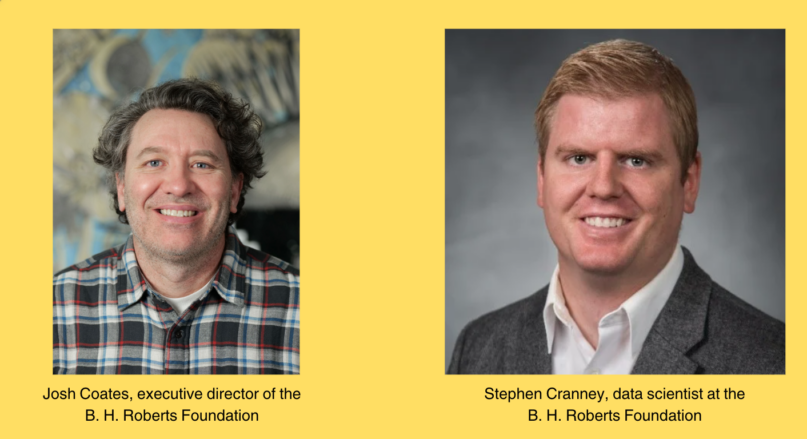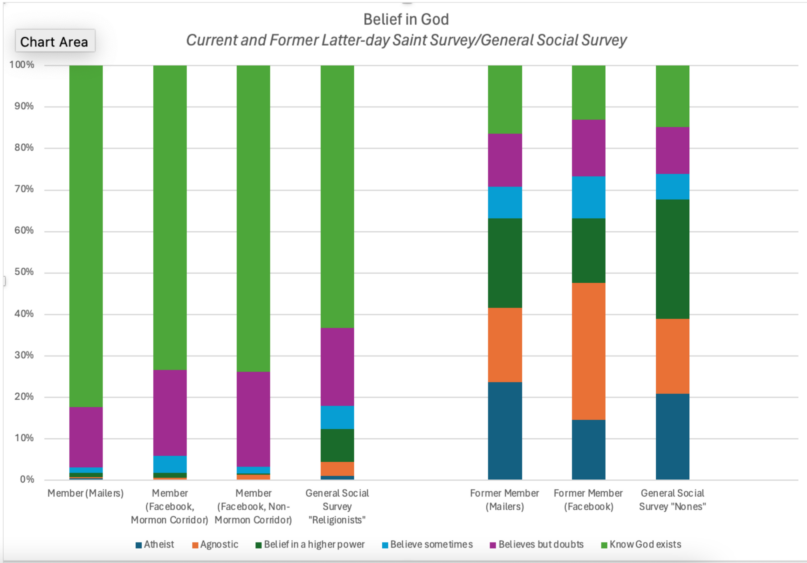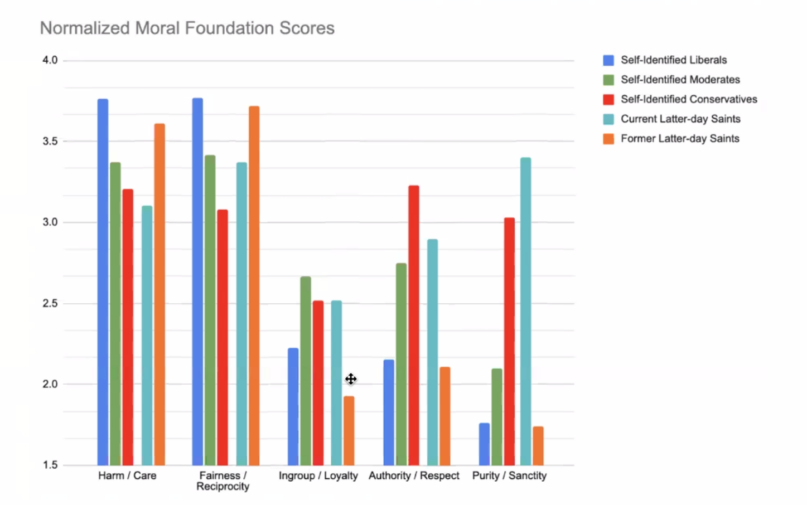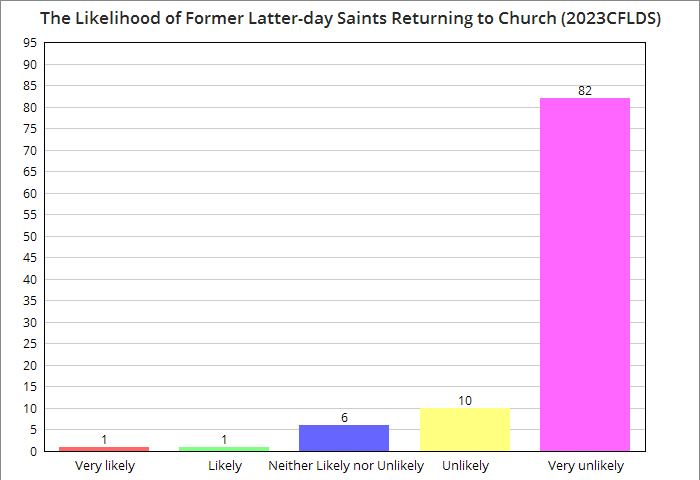(RNS) — When Josh Coates and Stephen Cranney wanted to learn more about members and former members of The Church of Jesus Christ of Latter-day Saints, they had to strategize about the best ways to reach them. More and more people aren’t answering surveys, either by phone or online. Reaching a small minority population like Latter-day Saints is notoriously difficult.
So they resurrected an old-school methodology — sending 80,000 physical postcards to randomly selected households in the Mormon Corridor — and supplemented with targeted Facebook ads to a Utah audience. Both methods led respondents to take an online survey that was then weighted to be representative of the LDS population. After they removed late and invalid responses, they had a sample of 2,625 current and 1,183 former Latter-day Saints.
Our Zoom interview about their findings has been edited for length and clarity.

1. Former members are more likely to be LGBTQ.
In the survey, only 4% of current members identified as LGBTQ, compared with 18% of former members.
“There’s a million questions to be asked there about why there’s a four times difference between current and former,” said Coates. “One theory is that if you’re LGBT and you’re in the church, it’s not 100% compatible, and you’re going to leave. And so obviously that means there’s going to be a lot more former Latter-day Saints. Undoubtedly there is a component to that. Or it’s possible that people that leave the church and then begin to identify as LGBTQ for whatever reason. We don’t know, because the survey did not explore any of that level of detail. That’s the next level.”
2. Few have a traditional belief in God, without any doubts.
The 2023 Current and Former Latter-day Saint Survey repeated a long-standing question from the General Social Survey about belief in God. Comparing the current and former members, the differences in belief are stark: Among current members, more than 7 in 10 say they “know God really exists and … have no doubts about it.” That’s more than six times the rate of certainty about God among former members.

Belief in God for current and former Latter-day Saints. Data from the 2023 CFLDS/B. H. Roberts Foundation.
Cranney pointed out in an article in Times and Seasons that most former members do “still have some kind of belief in something higher,” but they’re less likely to know without a doubt that God exists. “Their belief in God is characterized more by ambiguity than a firm belief one way or another,” he wrote. In this, they’re similar to the nones in the general population of the U.S., while current members resemble the General Social Survey’s “religionists,” the most devout Americans.
3. Their moral priorities look very different.
One of the most groundbreaking aspects of the survey Coates and Cranney devised was that they utilized Jonathan Haidt’s Moral Foundations Theory to try to understand whether current and former Mormons emphasized different aspects of morality. MFT measures values such as fairness, loyalty, authority, care and purity. In Haidt’s research, liberals tend to stress fairness and care but put less emphasis on obedience to authority or being loyal to a particular tribe.
Former Mormons, it turns out, have much in common with liberals in the general population, with high ratings for care and fairness. Meanwhile, current members look more like conservatives, but with a particularly high emphasis on purity/sanctity — something former Mormons do not stress much at all.
“That was surprising, how defined that difference was,” Coates said. “Current Latter-day Saints are off the charts on purity and sanctity. And for former members what’s interesting is that in in-group loyalty, they’re significantly lower even than the liberals.”

Moral Foundations Theory scores for current and former Latter-day Saints compared with conservative, moderate and liberal groups in the national population. Data from the 2023 CFLDS/B. H. Roberts Foundation.
Cranney said that makes sense. “This is a relatively high-tension faith that, oftentimes to survive, has had to have fairly strict binding norms. People who have decided that it’s not for them are going to score lower because they have rejected those very intense binding norms.”
4. They are more likely to have been divorced.
For survey respondents who were still members of the LDS church, the divorce rate for first marriages was 18%, while for former members it was 39%. The former members’ rate is closer to the national average for divorces in the United States.
Coates said the rate of temple divorces is especially low, between 14% and 20%, while “marriages between members that are not sealed in the temple are closer to the national rate of about half of marriages ending in divorce.”
5. They have smaller families.
Coates cautions that the data on this is still provisional because accounting for age will make a major difference in the findings, but in terms of the raw numbers, current Latter-day Saints appear to have almost one child more per family (3.4 children) than those who’ve left the church (2.5 children).
6. Many say they left the church because of historical issues.
The top three reasons for leaving in the 2023CFLDS were 1) history related to Joseph Smith; 2) Book of Mormon; and 3) race issues.
However, Coates says he is somewhat skeptical, comparing these questions to asking divorced couples why their marriages failed. He says it’s difficult to know what potential conscious or unconscious biases are at play.
“We think this portion of the survey is only useful in answering the question ‘What do former members prefer to respond when asked on a survey why they left?’” he said.
7. The vast majority have no interest in returning to church activity.
More than 4 out of 5 former members say that returning is “very unlikely,” with an additional 10% saying it’s unlikely.

A strong majority of former members surveyed said it was very unlikely that they would return to LDS church membership. Data from the 2023 CFLDS/B. H. Roberts Foundation.
A majority has very negative feelings about the church. “Three out of 4 said they dislike or strongly dislike the church as an institution,” Coates reported. In brighter news, “they had a neutral to positive disposition toward the people.”
Cranney performed a regression analysis to see if he could isolate predictive factors that might shed light on which former Mormons were most likely to return to church. “The one thing that is associated with being more likely to say that you’ll return to the church is if you are married to a member,” he said.
That situation describes about a fifth of the former LDS sample: 20% were married to believing members, and 30% were married to fellow former members.
8. Most don’t join another religion after leaving.
Seventy percent of the former members selected “none” when asked to describe their religion now. However, Coates observed that the actual percentage could be even higher, because an additional 19% chose “other” and then hand-wrote responses that were sometimes compatible with “none.”
“They’re not joining another religion,” Coates said. “It’s possible that means they’re Christians without a congregation, but the question only asks ‘Hey, are you affiliated? Do you identify with a religion?’ And no, they don’t. I think that was our intuition about former Latter-day Saints, so that finding didn’t surprise us.”
Related content: Study: Utah is no longer a Mormon-majority state
Discover more from CaveNews Times
Subscribe to get the latest posts sent to your email.

























![Exploring the Serene Beauty of Nature: A Reflection on [YouTube video title]](https://cavemangardens.art/storage/2024/04/114803-exploring-the-serene-beauty-of-nature-a-reflection-on-youtube-video-title-360x180.jpg)


























